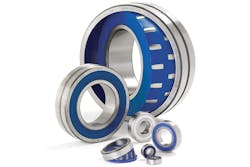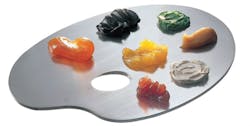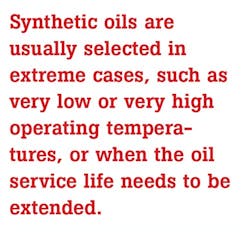Managing lubrication in food and beverage processing
Food and beverage processors must deal with particularly difficult and often harsh operating conditions that potentially impact equipment performance and reliability. Frequent washdowns, ingress of contaminants, corrosion and other adverse influences can affect an operation’s line efficiency, productivity and reliability. In addition, continuous pressure for processors to comply with strict health, safety and environmental regulations multiplies the operating challenges.
In these environments, proper lubrication practices for rolling bearings are essential to realize optimized performance and service life. As critical components in rotating machinery, rolling bearings support applied loads, locate the shaft and housing components, and reduce friction, heat generation and power consumption. They represent ripe targets for attack at every turn.
For example, preparation applications involving washing, sorting, grading, peeling, separating and/or blending can wet and contaminate preparation equipment. Large amounts of water or other liquids can create high humidity levels, while process particle contamination and caustic cleaning agents used during washdowns can inflict bearing and seal damage. As a result, the bearing lubricant can potentially become contaminated, degrade and/or leak out of the bearing. When the lubricant is compromised, the performance of bearings, seals and the machinery in which they operate will be jeopardized.
Image 1. Battery-powered, portable grease gun.
A proactive approach toward managing lubrication can help mitigate such problems and, in the process, increase line availability, improve efficiency, reduce maintenance costs, and enhance food and beverage safety and end products.
Delivering the lubricant
Lubricants serve to prevent wear and any resulting damage between a bearing’s rolling and sliding contact surfaces, reduce friction and heat generation, help protect against corrosion, and help keep out contaminants. Regardless of application, the right lubricant should always be supplied in the right quantity at the right time. An array of lubrication dispensing systems can be helpful for the machine operator or maintenance technician.
Many manual-lubrication technologies — some quite advanced and user-friendly — can be engaged for the job.
An example of a handheld tool appropriate for manually lubricating bearings is a rechargeable, battery-driven grease gun, which offers the portability, consistent performance and user-friendly interface to maximize efficiency and accuracy (see Image 1). With such a tool, lubricant flow rates can be precisely adjusted, and an integrated grease meter dispenses the proper amount of lubricant to prevent possible over- or undergreasing. A visual display further assists workers by showing battery charge level, amount of grease dispensed and even blocked lubrication points.
But manual lubrication has limitations and challenges. Lubrication points may be difficult or unsafe to access, or critical lubrication points may be overlooked. The dispense of excessive or insufficient grease into the lubrication point is a risk. When manual lubrication proves to be impractical, “hands-free” automatic lubricators and centralized lubrication systems provide solutions to correctly control lubricant application.
Automatic lubricators inject the precise and correct amounts of contaminant-free grease at single or multiple lubrication points. They inherently minimize the risks of over- or underlubricating and can supply lubricant 24/7 for periods up to a year as governed by preset automatic timers.
Single-line centralized systems use a central pump station to automatically deliver lubricant through a single supply line to a lubricant metering device. Each metering device serves only one lubrication point and can be adjusted to deliver the precise amount of required grease or oil. Such systems can pump long distances within a wide temperature range. And even if one lubrication point becomes blocked, the system continues to operate.
Dual-line centralized systems are designed for large machines with many lubrication points, long lines and particularly harsh operating conditions. They utilize two main lines supplied alternately with lubricant, respective secondary lines and fittings, an electrically or pneumatically driven pump with reservoir, dual-line feeders, solenoid valves and pressure switches or transmitters for main line monitoring and control unit. Such systems are engineered with the capability to deliver lubricant to hundreds of lubrication points.
Image 2. Single-point, automatic lubricator is an example of an automatic lubrication technology.
Progressive centralized systems dispense small, measured amounts of lubricant at frequent and intermittent intervals while machines operate. The grease or oil flow created by the system’s pump is proportioned by progressive metering devices and distributed to each lubrication point according to need. Such systems represent a relatively simple and inexpensive method of automating the lubrication process for machinery in service.
Eliminating the need to relubricate
Bearings are commonly overgreased during relubrication, which causes excessive grease to purge past the bearing seals. This is a common occurrence during manual relubrication of bearings and can potentially result in damaged bearing seals, food product contamination, slip and fall hazards, increased environmental waste and increased maintenance costs. Prompted by these and other issues, various technologies have been developed to virtually eliminate the need to relubricate.
Sealed-for-life, corrosion-resistant bearing units are lubricated for the lifetime of the bearing and do not require grease relubrication. These bearing units can be supplied in a variety of corrosion-resistant material options to satisfy the appropriate application and environmental conditions. The insert bearing can be supplied in corrosion-resistant stainless steel or a zinc-chromate coated steel, with the bearing housing offered in stainless steel or high-strength composite. The integral bearing seals are manufactured from high-performance, food-grade materials to provide excellent resistance to contamination ingress, abrasive wear and water or chemicals used during washdown. The contact seals increase the grease and bearing service life.
The NSF-H1 food-grade-approved, high-quality synthetic grease prepacked inside these bearing units is approved for use in all food processing and beverage industry applications. This synthetic grease was formulated for a wide operating temperature range, with good water resistance, high aging resistance for extended lubricant life and high load-carrying capacity to prevent premature bearing wear and damage.
Image 3 depicts an oil-saturated polymer material that virtually fills all of the free space inside the bearing, which is another option to eliminate relubrication tasks. The polymer material has a porous structure with millions of micropores that hold the lubricating oil like a sponge. The polymer matrix contains two to four times more lubricating oil than standard grease-filled bearings and will not leak or purge out of the bearing. The material is offered in most bearing types (except needle roller bearings), including stainless steel bearings.
The polymer is designed to help minimize the ingress of contaminants, resist most chemicals without emulsifying during harsh washdowns, withstand high centrifugal forces and to not wash out or otherwise contaminate the environment during production. The technology further can perform reliably despite extremely cold operating temperatures and rapid temperature changes that are typically experienced in a variety of food and beverage processing applications.
Turning to lubricants
Any discussion of lubrication naturally turns to the choice between grease and oil.
When feasible, grease is typically the preferred bearing lubrication choice because it is easy to apply, can be retained within a bearing’s housing and helps improve sealing against solid or moisture contamination.
Lubricating greases consist of a mineral or synthetic base oil that is suspended in a thickener or soap. Additives may also be introduced to impart characteristics such as protection against wear or corrosion and friction-reducing properties. By varying base oil viscosities, thickeners and additives, greases can be developed with distinct characteristics to satisfy particular applications and operating conditions.
Oil lubrication will usually be specified when high speeds, high temperatures or lubricant life and cleanliness preclude the use of grease. When application conditions permit, the advantages of oil include easy filling and draining, increased bearing speed capability, reduced heat generation and the capability to filter contaminants.
Mineral oils represent the most common oil lubricant choice for rolling bearings because of their good performance for a wide range of applications. Synthetic oils are usually selected in extreme cases, such as very low or very high operating temperatures, or when the oil service life needs to be extended. Rust and oxidation inhibitors are typical additives for extending the life of lubricating oils, and extreme pressure (EP) and anti-wear (AW) additives are used in special cases to reduce bearing wear and extend bearing life.
The entire universe of food-grade lubricants has been expanding to accommodate application and industry needs for improved product safety. Such lubricants have been specially formulated to perform reliably in the typical application conditions of the food and beverage industry, while also meeting health and safety regulations.
Examples include general purpose greases that have excellent water and moisture resistance, high- or low-temperature greases, general purpose chain oils, high-moisture chain oils, high-temperature chain oils, dry film lubricants, and hydraulic and gear oils, among many others.
Food-grade lubricants should be approved by the National Sanitation Foundation and United States Department of Agriculture for food exposure and safety. Food-grade lubricants with an H1 approval are safe in the event of incidental food contact. Additionally, food-grade lubricants can support Hazardous Analysis and Critical Control Point (HACCP) processes to contribute toward improved safety in applications plant-wide.
Making critical lubrication decisions will contribute to the success or failure of equipment in service – but decision-making can become complicated since no single universal lubricant exists to cover all application scenarios. Partnering with a knowledgeable lubrication specialist is a recommended first step toward understanding and implementing best lubrication practices tailored to the application.
Matthew McCormack is an applications engineer at SKF USA Inc., based in Lansdale, Pennsylvania. He can be reached at [email protected] or 267-436-6821. For more information, visit skfusa.com.






